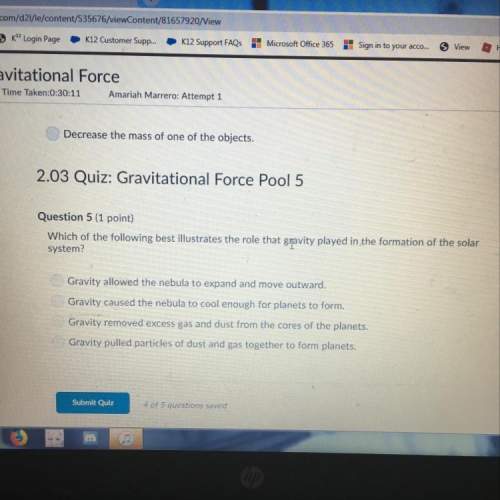
During a demonstration of Newton's laws of motion, a student used the
setup shown in Figure 1. The student flicked the index card with a
fingertip, and the coin fell straight down into a plastic cup as shown in
Figure 2.
Figure 1
Figure 2
Which of these best explains why the coin fell straight down into the cup
instead of remaining on the index card? TEKS 8.6(C)
A The coin was at rest until the card was removed, so it tended to
remain in the same location. Once the card was gone, the
unbalanced force of gravity caused the coin to fall.
B Moving the card applied an action force on the coin. Since the card
was gone, gravity applied a reaction force on the coin.
C The card had less mass than the coin, so a smaller force of gravity
acted on the card. The larger force of gravity on the coin made it
fall.
D The acceleration of the coin falling into the cup was equal and
opposite to the acceleration of the card.


Answers: 1


Another question on Chemistry


Chemistry, 22.06.2019 13:30
How many protons, electrons, and neutrons are in each of the following isotopes? a. zirconium-90 b. palladium-108 c. bromine-81 d. antimony-123
Answers: 1

Chemistry, 22.06.2019 18:30
Asample of hydrated tin (ii) chloride (sncl2) has a mass of 4.90 g. when it is dehydrated, it has a mass of 4.10 g. which is the correct chemical formula for the hydrate? sncl2•2h2o sncl2•4h2o sncl2•6h2o
Answers: 2

Chemistry, 22.06.2019 22:10
Determine the ph of 0.10 m nh3 solution. nh3 is a weak base with a kb equal to 1.8 x 10-5 round answer to nearest whole number.
Answers: 1
You know the right answer?
During a demonstration of Newton's laws of motion, a student used the
setup shown in Figure 1. The...
Questions







English, 05.12.2019 21:31










Computers and Technology, 05.12.2019 21:31







